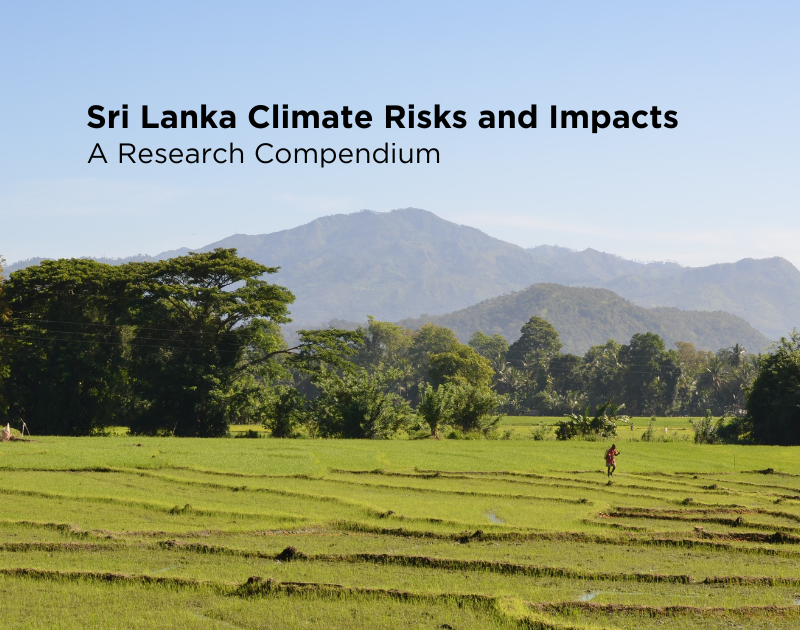
- Home
- Knowledge Insights
- Why Sri Lankan Banks Must Urgently Consider Climate Risks in their Lending
Sri Lanka’s banking and finance sector stands at a critical juncture. While traditional risk assessment models focus on creditworthiness, market volatility, and regulatory compliance, a far more existential threat looms over lending portfolios across the country. Climate change is no longer a distant concern for future generations – it represents an immediate and quantifiable risk that demands urgent integration into every credit decision and portfolio assessment. This was also a key focus at the recent Financial Stability Conference organized by the Central Bank, where leading international experts like Prof. Ulrich Volz of SOAS, University of London, reiterated the risks emanating from climate change and nature loss to financial sector stability.
The numbers paint a stark picture. Sri Lanka faces a projected 3.86% reduction in GDP by 2050 due to climate impacts alone. For financial institutions, this translates to systemic risk across virtually every sector of the economy. When over 80% of the population lacks adaptive capacity to increasingly frequent disasters, and nearly 19 million Sri Lankans are estimated to live in climate hotspots by 2050, the question isn’t whether climate risks will materialize – it’s how severely they will impact borrowers’ ability to service their debts.
Agriculture Sector
Agriculture remains a cornerstone of Sri Lanka’s economy, with 90% of farmers operating as smallholders on less than two hectares. Yet this sector faces devastating climate projections. Paddy yields are expected to fall by 12-19% in the Maha season and 27-41% in the Yala season by the 2060s. In the Jaffna peninsula alone, 43% of paddy land has been permanently abandoned due to soil salinization, with 59% of wells unsuitable for crop irrigation by 2020.
The extended droughts and floods of 2016-2017 interrupted two rice production cycles, affecting over 2 million people. These aren’t isolated incidents but previews of intensifying climate patterns. Between 2013-2019, over 90,000 people abandoned agriculture as their primary livelihood annually. For banks with significant exposure to agricultural lending, these trends represent a fundamental shift in sector viability that traditional risk models do not capture.
Coastal Infrastructure
With 50% of Sri Lanka’s population living in coastal areas and 25% within one kilometer of the shore, coastal infrastructure represents massive banking exposure to sea-level rise, storm surges and coastal erosion risks. Coastal areas could experience erosion of 15-25 meters by 2032, extending to 45-78 meters by 2042. In the southwest lowlands, 40-90 square kilometers could be completely inundated by 2050.
Consider the implications for mortgage lending in these areas. Properties securing loans today may be partially or completely submerged within the typical 20-30 year mortgage term. Commercial loans for coastal tourism infrastructure face similar risks, with sea-level rise, increased erosion, and extreme weather events threatening the viability of beach resorts, restaurants, and maritime facilities that currently anchor significant portions of banking portfolios.
Cascading Effects Across Sectors
Climate risks in Sri Lanka don’t operate in isolation – they cascade across interconnected economic sectors. The fisheries sector, which provides livelihoods for 2.4 million people and 70% of animal protein intake, has seen fish resources plummet from 300,000 tonnes in 1980 to just 53,000 tonnes in 2018. Sri Lanka faces a projected 20% reduction in fish harvest by the 2050s solely due to climate change effects, threatening both direct fishing industry loans and the broader food security that underpins economic stability.
Manufacturing and tourism sectors face their own climate vulnerabilities. Extreme weather events are already disrupting economic activities, while rising temperatures will increase cooling requirements by at least 10% by the 2040s, straining energy infrastructure. Other than sea level rise, tourism infrastructure faces direct threats from flooding and extreme heat events that could fundamentally alter the industry’s economics.
Cost of Inaction
Sri Lanka already spends over $310 million annually on disaster losses and relief, with floods alone causing approximately $140 million in annual losses—about 65% of all disaster-related economic damage. By the 2030s, annual GDP losses could reach $338 million under moderate warming scenarios. More alarmingly, these losses could climb to 1.2% of annual GDP ($1 billion) by 2050 even under current trajectories.
For the banking sector, these figures represent loan defaults, collateral devaluation, and sector-wide instability that will dwarf traditional credit risks. For instance, the housing, roads, and relief sectors are estimated to lose $380 million annually due to climate catastrophes over the long term. Banks with exposure to these sectors face systematic repricing of risk that current models don’t account for.
Glaring Gap in FIs
Research by CSF in 2023 that examined 56 Sri Lankan financial institutions revealed a troubling disconnect between climate risk reality and institutional preparedness. While 22 firms demonstrate some environmental integration intent, only 5 out of 47 lending institutions systematically assess environmental impacts and risks when granting loans. Even more alarming, just 2 financial institutions indicate they categorize sectors most vulnerable to climate risk, and only 2 review critical environmental risks like transition and physical risks in their portfolios. This means the vast majority of Sri Lanka’s financial sector is operating without the most basic climate risk assessment frameworks, even as the country faces some of the world’s most severe climate vulnerabilities.
Strategic Re-orientations
The solution isn’t to retreat from lending but to fundamentally reimagine risk assessment frameworks. Climate risk integration must become as routine as credit scoring, involving detailed geographic analysis of collateral locations, sector-specific climate vulnerability assessments, and borrower adaptation capacity evaluation.
Banks must begin stress-testing portfolios against climate scenarios, not just business cycle volatility and growth scenarios. Loan pricing should reflect climate risk premiums, particularly for borrowers that have not taken adaptation measures. This isn’t about penalizing businesses but accurately pricing risk and incentivizing climate adaptation investments.
But lending institutions cannot stop at this – while better accounting for the risks, they must better prepare the economy to face the challenges through reorienting lending and stepping up green finance. Many Sri Lankan banks have now begun their green finance journey, but have focussed mostly on mitigation, like rooftop solar and other renewable energy projects. Climate resilience and adaptation remains underfunded.
Financial institutions should view Sri Lanka’s projected $36.5 billion climate resilience investment needs by 2030 as a massive opportunity. Green lending, climate adaptation financing, and funding resilient infrastructure represent emerging lending opportunities that forward-thinking banks can capture while building more sustainable portfolios.
The Bottom Line
Climate risk is credit risk. Financial institutions that continue operating under pre-climate risk assessment frameworks are exposing their depositors and shareholders to a risk that is already now well established. The data is becoming clearer, the expertise among environmental and climate scientists in Sri Lanka is growing, technology solutions to draw scenarios are more advanced, and the financial implications are quantifiable.
The question for Sri Lanka’s banking sector isn’t whether to integrate climate considerations into lending decisions – it’s whether to lead this transformation or be overwhelmed by it. The institutions that begin this work immediately will not only protect their portfolios but position themselves as leaders in the climate-resilient economy that Sri Lanka must build to survive and thrive in the decades ahead.
This article originally appears in the Sunday Observer newspaper of 1st June 2025.
Information for this article draw on the ‘Sri Lanka Climate Risks and Impacts: A Research Compendium’ by CSF, and from CSF research on ‘Environmental Integration by Sri Lankan Financial Institutions’.


